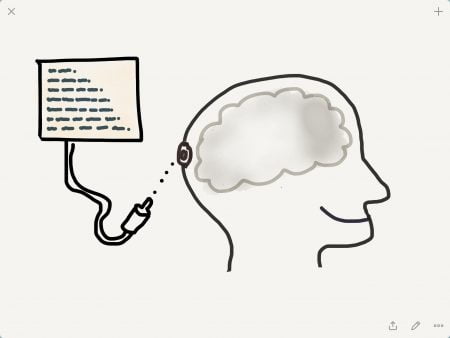Let’s face it. We all have to interact with organizations and systems of relationships in which we might not “fit” perfectly. We can choose to stay and try to thrive, or leave and find another path. Both are valid options. If you are choosing to stay, you will likely have to make minor (or sometimes major) tweaks to how you interact and function within that system. It is unreasonable to expect a system with thousands of employees or a family with 4 people in it to all change and adapt to you when you are unwilling to make changes to adapt to it.
What if you began approaching your brain like a computer system? Suppose you could load in a set of operating instructions at the beginning of every day to govern how you operate in the world around you. As you find “bugs” (character flaws) in your system, suppose you could write new code to help you begin to correct those bugs. I think we can actually do this.

Computers boot up with an operating system that tells the hardware (printer, mouse, monitor, etc.) how to function and runs the software apps. The operating system is the first program the computer loads when you turn it on. In a sense, the operating system directs everything else in the computer system.
You can write a personal operating system (POS) that directs your physical and mental functioning. The POS can be a very powerful tool to help you change behavior that is holding you back in your professional and personal life.
Here’s the basic idea:
- Write a set of instructions (the POS) that you want to be your governing principles.
- Read the POS every morning out loud.
- Each evening before bed, celebrate the wins from the day as you reread the POS.
Aspirational Lines of Code
Since this is you talking to your own body and brain, it’s important that you are kind to yourself. Negative instructions tend to focus on past behavior. The personal operating system should be a set of instructions on what TO do in the present and future. The instructions you give yourself every day should be affirming and aspirational. Any instruction can be written in a negative or positive way.
Here’s a line of code for running your brain:
Negative code: Don’t brag.
Positive code: Be humble.
And another line of code for running your body:
Negative code: Don’t eat crap.
Positive code: Choose healthy food.
A personal operating system should consist of approximately 5-15 lines of code that set up instructions for your brain and body. Here are several lines of code from the personal operating system I used last year, when I worked with a very large team in a leadership position:
Schedule impulsive things.
Support the leaders around you.
Focus on the big deliverables.
Give everyone a chance to shine.
Communicate down as well as up.
Do something scary every day.
The goal for a personal operating system is to create a set of reminders that become so well-known to you that they pop up in your mind when you are confronted with situations that run counter to your operating system.
Writing the First Draft of your POS
How do you go about creating your own personal operating system?
There are several questions you can use for reflection that will give you a good first draft:
- If I were to ask people around you to describe you, what would you want them to say about you?
- What are the characteristics of the people you you admire and look to as role models?
- What are the character flaws that are keeping you from moving up or into new roles at work?
- What are the character flaws that are keeping you from having more meaningful relationships with your partner, children, or friends?
As you identify flaws, remember that you need to find ways to write affirming statements (not negative ones) for the operating system.
Getting Feedback on the POS
This may be too scary for your first POS, and if that’s the case, just skip this step. However, it can be a really valuable way to nail the instructions that will be the most powerful in transforming yourself.
To get feedback on your draft POS, you want to identify 2-5 trusted people (friends, family members, or former work colleagues) that will read the POS and tell you what you’re missing. Ask them questions like:
- What is holding me back at work?
- What is holding me back from deepening our relationship?
- What should be on this list that isn’t?
Approach the feedback you get with this mindset: I will listen to what they say without argument.
Now revise your POS in a way that you think is appropriate. You can take it or leave it with respect to the feedback you got, but you did ask for it, so I’d consider taking it if you truly asked people you trusted.
Finalize the POS
As you get the POS ready to be used, consider how it should be written on paper. Do you want your POS to be loaded from shortest statement to longest statement?
Be humble.
Choose healthy foods.
Schedule impulsive things.
Focus on the big deliverables.
Do something scary every day.
Support the leaders around you.
Give everyone a chance to shine.
Communicate down as well as up.
Does it make more sense to you to group the POS so that personal and work goals are separated?
Be humble.
Choose healthy foods.
Do something scary every day.
Schedule impulsive things.
Focus on the big deliverables.
Support the leaders around you.
Give everyone a chance to shine.
Communicate down as well as up.
Or maybe it makes more sense to you to organize the list so that the hardest instructions always come first.
Be humble.
Choose healthy foods.
Focus on the big deliverables.
Schedule impulsive things.
Do something scary every day.
Support the leaders around you.
Give everyone a chance to shine.
Communicate down as well as up.
Finalize the order. Print the list (you may need a few copies depending on your morning and evening routines). You might want to laminate the list (packing tape works well), mount it on cardboard, decorate it, or do something else to make it feel more like a permanent structure in your life. It’s your POS, figure out what makes sense to you.
Loading the POS in the Morning
The POS will only work if you actually READ it every morning. So you have to find a place to put it where you will have the time to read the list out loud with minimal disruption to your normal routine. Try to think of a time when you’ll be likely to be able to read the list. For me, the ideal time is when I’m drying my hair, so my list is in the bathroom. For you it could be while you wait for your coffee to brew, when you are making your breakfast, or while you drive to work.
Find a home for your POS, and make it a part of your routine to read the list of instructions every morning.
Reread the POS in the Evening
Now find a time in the evening that you can skim your list and celebrate the wins and small corrections you made during the day. Again, the bathroom might be the right place (I reflect while I brush my teeth). You don’t want to beat yourself up if you didn’t manage to execute all your instructions. The goal is to find where an instruction did actually lead you to a new behavior during the day. You want your mind to begin to deliver the correct instruction at the moment you need to hear it. For example, at the moment that you are about to brag about an accomplishment at work, “Be humble.” floats into your mind and you congratulate the team on a job well done instead of bragging. That’s a win to be celebrated at the end of the day.
Of course, you might also identify moments in the day where you could have done better, and that’s okay. You simply need to acknowledge them, and then dismiss them with the thought that you’ve now recognized these types of moments and can improve another day.
Tuning Up the POS
As time passes and jobs and relationships change, your POS will need tuning up. Don’t operate on an old POS when your life has had significant changes. The example POS I’ve shared makes little sense now that I’m self-employed and no longer working with an enormous organization with a large team to manage. I’ve revised it. You should too as your situation changes.
I would love to compile a list of instructions that people can choose from to write a POS. What are some of the “lines of code” you’re writing into your own personal operating system?



